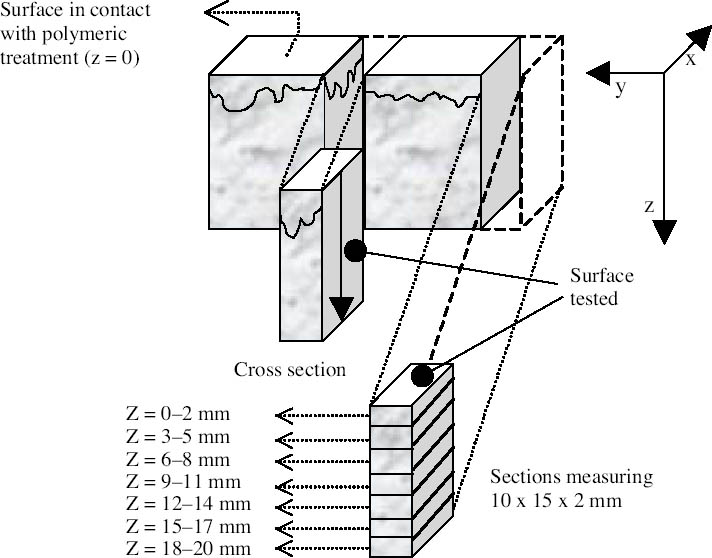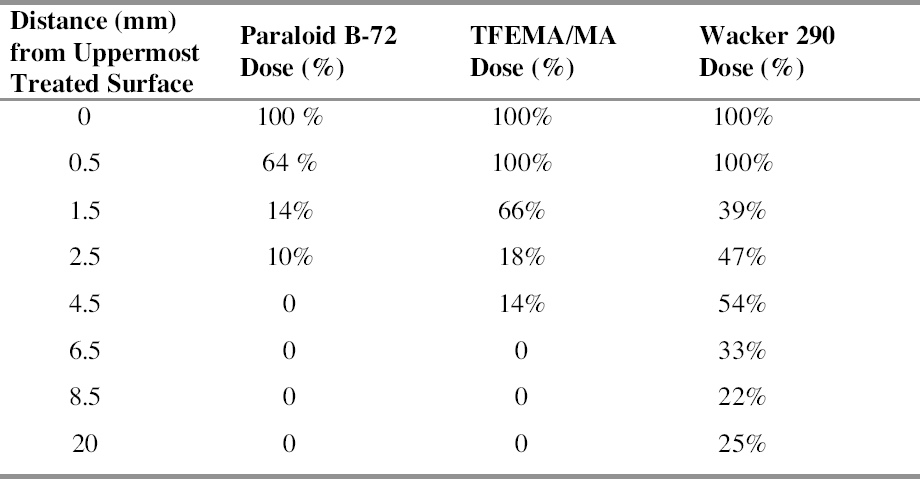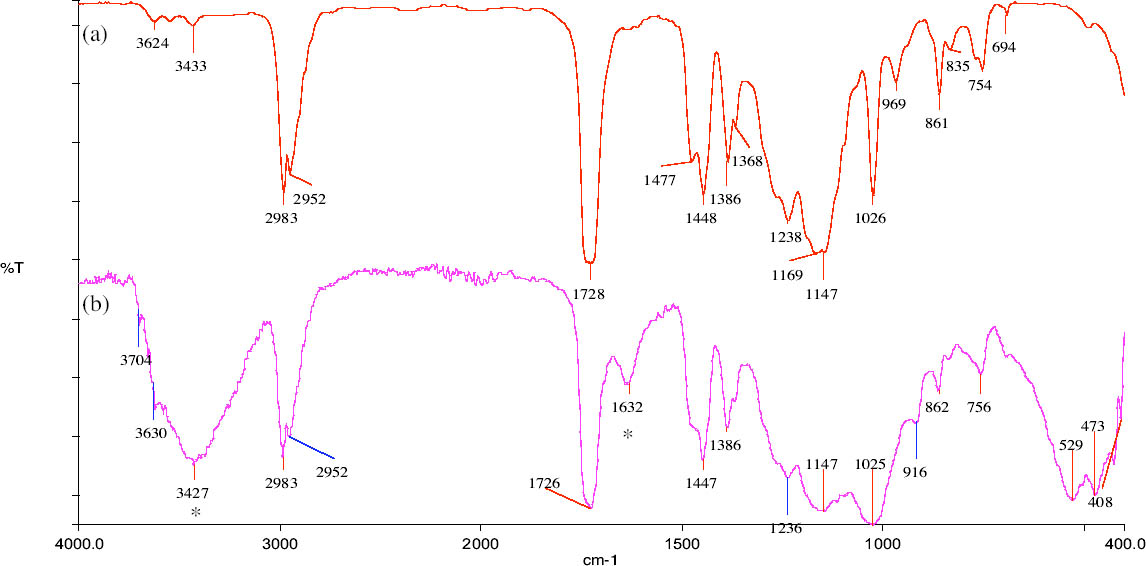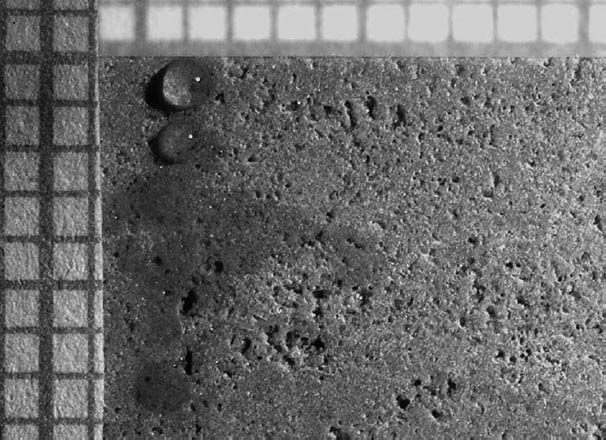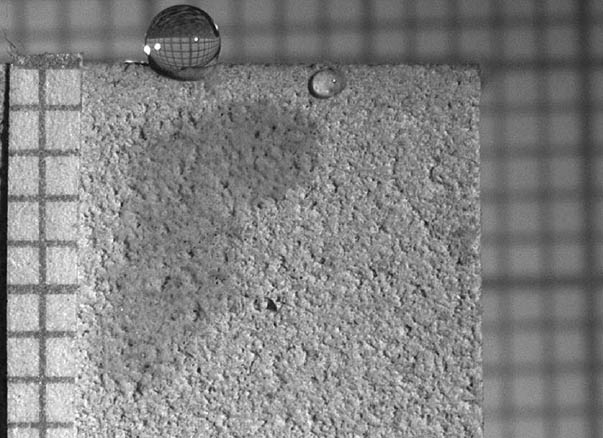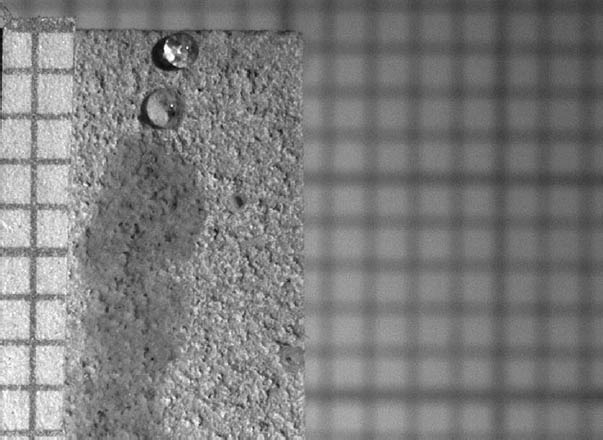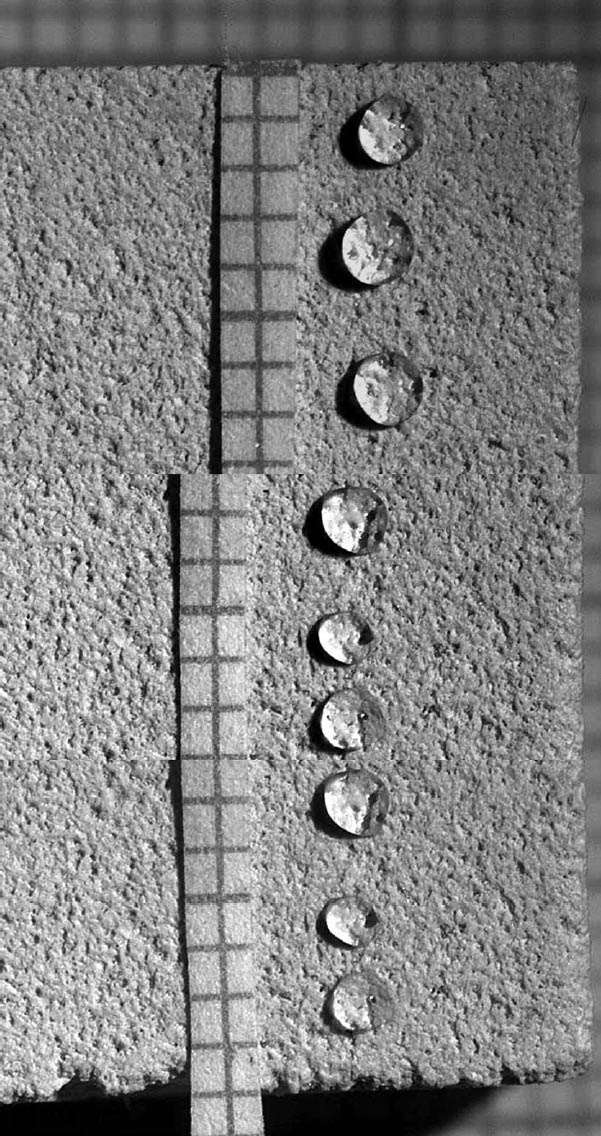POLYMER TREATMENTS FOR STONE CONSERVATION: METHODS FOR EVALUATING PENETRATION DEPTHFRANCESCA CASADIO, & LUCIA TONIOLO
ABSTRACT—This study examines the measurement of penetration depths for three polymer treatments for stone conservation—acrylic, partially fluorinated acrylic, and siloxane polymers. The treatments were tested on three types of calcareous stones of increasing porosity, widely present in historic architecture and monuments in Italy. Various approaches were explored, including direct determination with various Fourier transform infrared spectroscopic techniques (micro-attenuated total reflection, diamond cell transmission, and hyphenated with thermogravimetry) as well as indirect methods such as static angle measurements. Micro-attenuated total reflection on cross sections of treated specimens proved to be a particularly powerful technique for detection of polymers, with fairly good spatial resolution and sensitivity. The degree of penetration of polymers inside the porous matrix of stone is an important parameter when evaluating the efficacy and durability of treatments. Therefore, developing reliable testing methods for determining penetration depth is crucial. TITRE—Le traitement de la pierre � l'aide de polym�res: m�thodes pour �valuer le degr� de p�n�tration. R�SUM�—Cette �tude examine le degr� de p�n�tration de trois diff�rents polym�res utilis�s pour traiter la pierre: l'acrylique, l'acrylique partiellement fluor� et le siloxane. Les traitements ont �t� effectu�s sur trois types de pierres calcaires de porosit� vari�e, qui sont fr�quemment utilis�es dans les �difices et monuments historiques en Italie. Diverses approches ont �t� test�es, dont la d�termination directe avec diff�rentes techniques spectroscopiques infrarouges par transform�e de Fourier (r�flexion totale micro-att�nu�e, transmission en utilisant une cellule � enclumes de diamant et d�termination progressive par thermogravim�trie), ainsi que des m�thodes indirectes telles que des mesures statiques des angles. L'�tude par r�flexion totale micro-att�nu�e sur des coupes stratigraphiques de sp�cimens trait�s s'est av�r�e �tre une technique particuli�rement efficace pour la d�tection des polym�res, avec une r�solution spatiale et une sensibilit� ad�quate. Le degr� de p�n�tration des polym�res � l'int�rieur de la matrice poreuse de la pierre est un param�tre important pour �valuer l'efficacit� et la long�vit� des traitements. Par cons�quent, il est crucial de d�velopper des m�thodes fiables pour d�terminer le degr� de p�n�tration. TITULO—Tratamientos con pol�meros para la conservaci�n de la piedra: m�todos para la evaluaci�n de la profundidad de penetraci�n. RESUMEN— Este estudio examina las mediciones de profundidad de la penetraci�n de tres tratamientos con pol�meros utilizados en la conservaci�n de piedra—acr�lico, acr�lico parcialmente fluorinado y pol�meros de siloxano. Estos tratamientos fueron realizados sobre tres tipos de piedras calc�reas cada una de mayor porosidad que la anterior, las cuales son encontradas muy frecuentemente en monumentos y arquitectura hist�rica en Italia. Se exploraron varias formas de enfocar esta investigaci�n, incluyendo una determinaci�n directa con varias t�cnicas de espectroscop�a infrarroja con transformadores de Fourier—FTIR (reflexi�n total micro atenuada, transmisi�n de c�lula de diamante, y termogravimetr�a en t�ndem con FTIR), tanto como m�todos indirectos tales como las medidas de �ngulo est�tico. La reflexi�n total micro atenuada sobre cortes estratigr�ficos de las muestras tratadas result� ser una t�cnica particularmente potente para la detecci�n de pol�meros, con una resoluci�n espacial y sensibilidad bastante buena. El grado de penetraci�n de los pol�meros dentro de la matriz porosa de la piedra es un par�metro importante cuando se eval�an la eficacia y durabilidad de los tratamientos. Por lo tanto, el desarrollo de m�todos de examen que sean confiables es crucial para determinar la profundidad de penetraci�n. T�TULO—Tratamentos com pol�mero para conserva��o de pedra: m�todos para avaliar a profundidade de penetra��o. RESUMO—Este estudo trata da medi��o da profundidade de penetra��o em tr�s tratamentos com pol�meros para 1 INTRODUCTIONProcedures for testing stone materials treated with polymer products are available in the literature, formulated by both national (in Italy, the NorMaL Commission) and international committees (RILEM; working groups 25 PEM and 59 TPM). Recommended tests primarily involve assessing the performance of polymers and measuring detectable variations in the macroscopic properties of the treated substrates, such as, for example, superficial colorimetric characteristics, porosity, capillary water absorption, water vapor absorption, superficial water repellency, and strength. Very little attention has been given, however, to penetration depths achieved by various polymer products or blends of products available and widely used for conservation purposes. D. Honeyborne reported “as long ago as 1932” that “a common cause of failure of stone preservatives is that, even in porous materials, and under the most favorable conditions, the preservative penetrates only to a relatively small depth, and a surface skin is formed which differs in physical properties from the underlying material” (quoted in Ashurst and Dimes 1990, 158). Similarly, in a detailed review of current research on stone conservation in 1996, Price (1996, 19) stated that “little attention has been given to the distribution of products within stone at the microscopic level. Little is known about the bonding, if any, that takes place between treatment and the substrate, and much is left to chemical intuition.” Still another discussion of the issue of polymer penetration is presented by Charola (1995, 13), who argues that
The depth of penetration of solutions of polymers within the stone matrix is strictly correlated to:
This article addresses the issue of measuring the actual penetration depth achieved by polymer treatments, reporting the development and evaluation of different testing methods. To explore the capabilities of the various methods proposed, polymers belonging to two very widely employed classes—acrylics and siloxanes—were studied. In particular, an experimental partially fluorinated acrylic polymer (TFEMA/MA; 2,2,2 trifluoroethylmethacrylate/methylacrylate copolymer), whose synthesis, characteristics, and applications have been described in detail in previous studies (Alessandrini et al. 2000a; Ciardelli et al. 2000), was tested Paraloid B-72 has been extensively used in Italy since the early 1970s both as a consolidant and as protective treatment (Roby 1996), although its water repellency cannot be considered fully satisfactory. Acrylics are very interesting materials for applications in conservation, however, because they remain almost soluble, and therefore removable, after curing and over time. Indeed, TFEMA/MA has been developed with the aim of enhancing the water repellency of an easily fine-tunable acrylic structure so as to obtain a fairly good protective material. The introduction of fluorine in a short side chain of the macromolecule, in fact, guarantees very good performance and satisfactory durability (Alessandrini et al. 2000b; Toniolo et al. 2002). Among the siloxanes, poly-dimethylsiloxane, Wacker 290, was selected. This product achieves good protective performance thanks to the adhesion properties and stability of its cross-linked structure (van Hees et al. 1997). All the polymers were applied on stone materials by capillary absorption, which offers controlled and reproducible conditions of treatment. The concentration and solvents in the polymer solutions were the same as those currently used in conservation practice. 1.1 OVERVIEW OF CURRENT RESEARCH ON POLYMER PENETRATIONTwo approaches are viable for determining the depth of penetration of polymers within a porous stone substrate: 1. direct methods, involving either staining tests (with 1, 5-diphenylthiocarbazone, iodine vapor, Rhodamine B, and other fluorescent dyes) or direct detection of the applied product by instrumental chemical analysis, primarily with analytical techniques such as Fourier transform infrared spectroscopy (FTIR), scanning electron microscopy‐energydispersive x-ray spectrometry (SEM-EDX), and x-ray photoelectron spectroscopy (XPS) 2. indirect methods, involving assessment of the polymer treatment's modification of stone materials. For protective products, such modifications are connected to variation in water repellency and physical properties related to interaction with water. The methods include measurement of contact angle, water drop absorption time, acid etching, capillary water absorption, and water absorption through a pipe. If the product shows consolidating properties, indirect methods of analysis can also include measuring physical‐mechanical parameters such as bending strength, splitting tensile strength, modulus of elasticity, drilling resistance, and ultrasonic velocity. The penetration depth values thus obtained must be considered specific to each method, and data are complementary. For example, the water repellency and consolidating effect might be detected at different depths within the stone material, and, in addition, the polymer might be chemically identifiable even in areas where such effects are not evident. In general, published methods for determining penetration of polymers in stone matrix are indirect methods and are characterized by varying degrees of operational complexity. Pioneering work by Domaslowski (Domaslowski and Lehmann 1972; Domaslowski and Kesy-Lewandowska 1985; Domaslowski 1988) and Lewin (Lewin and Papadimitriou 1981) investigated the impregnation behavior of solutions of polymers in different solvents by immersing slices of the treated stone in hydrochloric acid (HCl) and assuming that portions insoluble in the acid were those reached by the polymer. The method is, of course, very approximate; the spatial resolution achievable is very low, and there is no indication as to what concentration of polymer within the stone matrix is sufficient for effectively shielding the inorganic substrate from acid attack. Kumar and Ginell (1997) published a simple procedure involving exposing cut sections of treated limestone to iodine vapor and visually assessing the penetration depths achieved by various polymers. This method is fast and requires only an easily accessible, inexpensive apparatus, but errors can result if it is not skillfully performed. Exposure time, for example, needs to be adjusted depending on product concentration, and if the test is executed prior to complete evaporation of the solvent, there is a risk that the solvent's penetration depth may be observed and recorded, rather than More recently a European interlaboratory research group published a comparative study of different methods for determining penetration depths of polymers in porous stone. This study was part of the European Community Hardrock project that developed and validated an innovative methodology for evaluating the mechanical characteristics of monumental stones and related materials (Leroux et al. 2000). Among the methods evaluated were spot tests with 1, 5-diphenylthiocarbazone (reacting with tin contained in catalysts for many silicone resins, but interference from other metals produced frequent false positives); wetting of treated surfaces and visual evaluation of hydrophobicity; microdrop absorption (a very simple and easy method, but not a very accurate one); acid etching of stone slices (applicable only to carbonate stone); microdrilling resistance (ineffective with marble); ultrasonic velocity tracing (more effective with sandstone). The results obtained by these authors indicate how indirect methods of analysis can establish penetration depth values. The study also revealed that the effectiveness of various tests depends on the nature of the stone substrate. That different laboratories obtained different values highlights the problem of reproducibility. More sophisticated indirect techniques are described by Giorgi et al. (2000), in which nuclear magnetic resonance (NMR) imaging is used to visually determine distribution of water inside treated porous stone, thus implying the distribution profile of protective polymers. In the past few years, numerous authors have evaluated the potential of this technique for mapping the distribution of polymers inside stone, but the results are still somewhat ambiguous (Piacenti et al. 1999; Alesiani et al. 1999, 2001; Borgia et al. 2000, 2001; Appolonia et al. 2001). As for direct methods for determining the depth of penetration of polymers within a porous stone substrate, a few publications describe applications of FTIR spectroscopy (Lemaire et al. 1996, 1997), either in transmission mode on samples only a few �m thick or in photoacoustic mode on unaltered samples taken from historic buildings subjected to hydrophobic treatments. FTIR spectroscopy in reflection mode was also used on sections of various stones treated with silicone resins and coordinated with measurements of water uptake of the same sections in order to link the hydrophobic properties of the treated stone to the presence of the polymer (Franke et al. 1997). It is worth noting, however, that the FTIR techniques employed by these researchers can be used to analyze only certain kinds of substrates. Photoacoustic spectroscopy, for example, can be used to investigate only the sample's uppermost layers (approximately the first 20 �m): it is not suitable for depth-profiling. Reflection FTIR analysis is successful only with certain types of stone and is generally ineffective for porous substrates, as their rough surfaces give rise to poor specular reflectance. Finally, transmission FTIR spectroscopy requires samples to be so thin that they are transparent, only a few microns thick, supported on infrared absorption-free substrates. Thus sample preparation is a delicate and time-consuming operation, and some stone samples are likely to crumble to pieces in the process. Data on the chemical or physical-chemical interaction between porous stone and polymer product remain very scarce (Danehey et al. 1992; Elfving and J�glid 1992; Kumar 1995; Spoto et al. 2000; Rizzarelli et al. 2001). 1.2 RESEARCH AIMS AND EXPERIMENTAL APPROACHThe work described in this article explores various approaches using FTIR accessories and equipment to understand whether and how polymers penetrate inside the porous matrix of stone. Micro-attenuated total reflection (ATR), diamond cell transmission, and thermogravimetry-FTIR were evaluated. Depth-profiling of polymers inside stone substrates by direct determination with vibrational spectroscopic techniques has the advantage of It must be borne in mind that concentration of polymers inside stone materials is highly dependent on stone type but is always very low, ranging from a few grams to a maximum of approximately 500 g per square meter. These quantities, especially with lowporosity stone (such as marble), are often very close to the minimum detection limits of analytical instrumentation. Nevertheless, it is likely that the polymer can display its water-repellent effect even well below the instrumental detection limits. Therefore the analytical problems to be solved were particularly challenging. Indeed, the various instrumental setups and sample manipulations described here were developed in response to the need for detecting the presence and distribution of very small amounts of different polymers within the porous matrix of stone, with a widely used and well-established technique such as FTIR spectroscopy. 2 MATERIALS2.1 STONE SPECIMENSThe project focused on lithotypes of varying porosity, widely occurring in historic architecture and monuments in Italy. In particular, results are reported regarding substrates listed below:
2.2 POLYMER TREATMENTSThe resins used for treatment of the stone specimens were:
Details concerning these polymers' characteristics (including molecular weights and glass transition temperatures [Tg]), efficacy, and UV resistance are reported elsewhere (De Witte et al. 1993; Melo et al. 1999; Chiantore and Lazzari 2000; Alessandrini et al. 2000a, 2000b). 3 METHODS3.1 STONE TREATMENTSuitable stone samples, measuring 50 x 50 x 20 mm, were smoothed with abrasive carborundum paper (180 grit), washed with deionized water, and dried until constant weight was reached. Then the samples were treated by capillary rise absorption with solutions of the three different products: a 5% w/w solution of Paraloid B-72, a 5% w/w solution of TFEMA/MA, both in ethyl acetate, and an 8% w/w 3.2 TECHNIQUES OF ANALYSISDepending on the type of investigation performed, samples were prepared in two different ways for depth-profiling: treated samples were cut with a diamond precision saw (Struers Minitom) either as sections measuring 10 x 15 x 2 mm with plane surfaces parallel to the impregnated outer surface, or as cross sections, sawing along the direction of capillary rise of the solution, i.e., perpendicular to the treated uppermost surface (fig. 1). Cross sections were investigated with the following techniques:
4 RESULTS AND DISCUSSION4.1 MICRO-ATR SPECTROSCOPYExamination was performed on cross sections placed on the motorized microscope stage and subjected to repeated spectral recordings at increasing depths. The technique is very promising because it allows direct, nondestructive probing of the examined surface, coupling microscopic visible-light observation with infrared spectra as a function of Cartesian coordinates with a spatial resolution of 50‐100 μm, without further manipulation or preparation of the sample. The major drawback of the method is the need for perfect contact between the ATR probe crystal and the investigated micro-area (100 μm in diameter) to obtain a reasonable signal and an acceptable spectrum, a condition not easily achieved when investigating rough stone surfaces. In addition, the technique, like other infrared applications, is generally qualitative, allowing at best semi-quantitative assessment of the polymer's presence at different depths. Results obtained on highly porous calcareous
In the case of marble, a lithotype characterized by low total open porosity (< 1%), positive identification of the different polymers by the micro-ATR mapping technique was confined to the first few microns (around 100 �m) of the top surface. 4.2 DIAMOND CELL FTIRSince the main difficulty in direct determination of polymers in treated stones is often the dominating signal of the inorganic substrate, which masks the weaker signals of organic compounds, one analytical strategy involves eliminating the calcareous stone matrix by acid attack with 0.2 normal (N) HCl solution followed by analysis of the residues with diamond cell FTIR spectroscopy. By removing all interfering CaCO3, whose intense absorption bands often mask peaks belonging to the polymeric material, the presence of the different treatments can be unambiguously detected. Instead of probing a single cross section surface of a sample, this methodology
Acid attack was performed on powders ground from different sections of the samples to obtain information about the depth to which the polymer had penetrated. The technique proved to be more effective with stone substrates characterized by medium-high porosity values than with low-porous stones such as marble, since high-porous stones contained significantly higher quantities of polymeric materials. Samples of yellow Angera stone and Noto stone treated with Paraloid B-72 confirmed the tendency for the acrylic resin to form a film, as it was detected only in the uppermost section examined for both (i.e., within the first 2 mm). Figure 3 demonstrates how closely the spectrum obtained on the residue, after acid treatment, of the powder obtained from the uppermost section of a treated Noto stone sample matches the reference standard spectrum for Paraloid B-72. The only extraneous bands in the spectrum are those characteristic of silicates and iron oxides and hydroxides present in Noto stone and of calcium chloride (CaCl2) (as the bi-or hexahydrate salt, formed during treatment of CaCO3 with HCl), the latter centered at 1640 cm-1 in association with the broad band due to stretching modes of hydroxyl (OH) groups, centered at 3427 cm-1 (Nyquist and Kagel 1997). On the other hand, investigation of samples treated with Wacker 290 confirmed in-depth impregnation of both substrates by the siloxane oligomers. In fact, traces of the silicone resin were still detectable in sections corresponding to all levels inside the stone samples (fig. 1: positive detection down to section Z = 18‐20 mm). Figure 4 shows the spectrum obtained after acid dissolution of a section corresponding to 12‐14 mm inside Noto stone treated with Wacker 290. It is interesting to note that
In the case of marble, positive identification of polymers was possible only in the powders obtained by scraping the top surface of the stone samples with a scalpel. The treatment was invariably located in the uppermost region of the first cut section and, when sections cut from deeper regions were attacked with acid, no residue of polymer was recovered. 4.3 TG-FTIRThe combination of thermogravimetric and infrared analyses provides precise quantitative data on the various components of the investigated systems along with step-by-step infrared fingerprinting of volatile compounds emitted during thermal degradation. It is thus possible to ascribe each individual weight loss to the emission of certain gases, therefore identifying without any ambiguity the compound responsible for such weight loss. For the analysis, sections of the treated stone samples were ground and 30 mg of the resulting powder was placed in the platinum crucible of the thermobalance and submitted to heating from 40�C to 900�C at a speed of 10�C/min in helium flux. In the examined samples, the technique was capable of discriminating between organic polymer and inorganic matrix. Moreover, the method has the advantage of allowing precise quantitative determination of the doses of polymers, can highlight eventual interaction between the organic and inorganic phases, and has the benefit that, following cutting of the samples into sections, it requires very simple preparation. The main disadvantages of the technique are the limited spatial resolution due to the sample cutting procedure (see fig. 1) and its inappropriateness for resins with a complex degradation pattern (such as highly cross-linked resins) that leave a significant carbonized residue after degradation. As an example, no significant results were obtained from specimens treated with the siloxane Wacker 290 because of its
Differences in penetration depths reached by Paraloid B-72 and its fluorinated homologue in Candoglia marble and Noto stone were determined. On one hand, both resins were observed only in the first section of treated marble samples, corresponding to the first 2 mm of the uppermost surface. On the other hand, when applied on highly porous substrate such as Noto stone, TFEMA/MA was found to be present in two sections, corresponding to 5 mm from the top surface, while Paraloid B-72 was confined only to the first section. Moreover, the quantity of Paraloid B-72 impregnating the first section of the Noto stone sample was found to be equal to 5.7% of the total weight of sample analyzed, while it was equal to 0.43% in Candoglia marble. In the case of TFEMA/MA, 8.01% of the polymer was contained in the uppermost section of Noto stone, and 1.15% in the uppermost marble section table 3. It is interesting to note that the thermal degradation of the polymeric chains, corresponding to a maximum in the DTG curves, takes place at lower temperatures for the polymers applied on stone, with respect to temperatures observed for the pure polymers used as standard reference. This observation led to the hypothesis that polymers establish some electrostatic interaction with the stone substrate, resulting in slightly lower electronic density in proximity to the backbone of the polymer, which is, therefore, more susceptible to thermal degradation (i.e., slightly less energy is required to break the polymer chain).
4.4 STATIC CONTACT ANGLEThe determination of superficial water repellency of stone-polymer systems by measuring static contact angles can indicate the presence of polymers on porous substrates. When water repellency is measured on the surface of cross sections of treated samples, data obtained can be related to penetration depths of polymers inside the stones (Biscontin et al. 1993; Littmann et al. 1993; Delgado Rodrigues et al. 1996; Leroux et al. 2000). This very simple and lowtech method was used to check the general reliability of results obtained by various infrared spectroscopic approaches. Major advantages are the ease of measurement and the effective visualization of the hydrophobization of the substrate, which, in turn, indicates the actual polymer's presence within the stone material. Major limitations are low spatial resolution (due to the relatively large dimensions of the microdrops) and the nature of indirect measurements, which are sometimes prone to more ambiguity than direct determinations. The impregnating behavior of the three tested resins applied on medium (Angera stone) and high (Noto stone) porous stone was compared. Figure 6 reports values of contact angle measured on cross sections of treated Angera stone samples as a function of depth profile. It is evident that, while Wacker 290 evenly impregnated the whole sample, providing widespread water repellency, Paraloid B-72 was confined in the upper sections, since the stone immediately absorbed drops deposited 3 mm below the uppermost surface. Measurements of static contact angles at different depths were also associated with photographs, taken through a stereomicroscope, of the water-repellency properties of the tested surfaces. Water microdrops were deposited on the whole length of cross sections, and a photograph was taken after two minutes in order to record which, among the drops, retained their spherical shape because of the hydrophobicity of the surface and which, instead, had been absorbed. Results are shown in figure 7‐11. They clearly indicate
In the case of marble, static contact angles measured on the treated surface generally showed lower values than those measured on samples of more porous substrates treated with the same polymer material. Surface roughness is, in such measurements, the critical parameter directly correlated with the static angle values (Della Volpe et al. 2000) and, in the case of marble surfaces, the angles' values generally match those observed for the polymer itself when applied as a film on an inert and smooth substrate (glass or metal slides). Moreover, the testing of the marble cross sections did not allow visualization of water drops beneath the uppermost surface of the specimens, thus confirming the limited penetration of the various polymers on this substrate. 5 CONCLUSIONSThe results presented help to evaluate the potential of a wide range of infrared spectroscopic techniques, coupled to appropriate sampling methods, in identifying and characterizing, selectively and with good sensitivity, the depth of penetration of polymeric materials applied as protective treatments on stone substrates with different porosities. The experiments confirm that texture and porosity of the stone together with chemical nature and quantity of applied polymers can affect the pattern of resin distribution
In general, micro-ATR is considered the most powerful and widely applicable technique for characterizing types of polymers and substrates. Micro-ATR has the highest spatial resolution and precision among the evaluated methods when good contact between the ATR crystal and the examined surface is obtained. The other testing methods used in this study are also valuable, but they are affected by poor spatial resolution (due to the necessary sample preparation and cutting), and/or they are suitable for only a limited number of specific classes of polymers and stones. For example, TG-FTIR is effective for substrates treated with acrylics but not silicone resins, while diamond cell FTIR analysis of the residues of acid attack is useful only for calcareous stone, not for sandstones. Application of these methods to the depth-profiling and mapping of polymer distribution within treated stones allows differentiation of various polymer behaviors. For medium-to-high porous stones (Angera limestone and Noto calcarenite), the following conclusions can be drawn:
With regard to stone substrates with very low porosity (such as marbles, where penetration depths are limited, i.e., <1 mm), the precise determination of penetration depths requires application of analytical techniques displaying higher spatial resolution. These will allow discrimination among polymers penetrating a range of a few hundreds microns of depth.
ACKNOWLEDGEMENTSThe authors wish to thank Professor Franco Cariati for setting up the TG-FTIR instrument and for scientific advice given throughout the research work. The Fondazione Laboratorio Materie Plastiche is thanked for kindly making available the micro-ATR equipment. The Progetto Finalizzato Beni Culturali is also gratefully acknowledged. REFERENCESAlesiani, M., S.Capuani, L.Mancini, B.Maraviglia, R.Giorni, and P.Baglioni. 1999. Application of nuclear magnetic resonance tomography in the study of porous materials: Stones and mortars of historical and artistic value. In Proceedings of the Second International Congress on Science and Technology for the Safeguard of Cultural Heritage in the Mediterranean Basin, Paris, July 5–9 Paris: Elsevier. 483–85. Alesiani, M., S.Capuani, B.Maraviglia, R.Giorni, and P.Baglioni. 2001. NMR relaxation times in treated marble samples. Magnetic Resonance Imaging19(3–4):569. Alessandrini, G., M.Aglietto, V.Castelvetro, F.Ciardelli, R.Peruzzi, and L.Toniolo. 2000a. Comparative evaluation of fluorinated and unfluorinated acrylic copolymers as water-repellent coating materials for stone.Journal of Applied Polymer Science76:962–77. Alessandrini, G., L.Toniolo, and C.Colombo. 2000b. Partially fluorinated acrylic copolymers as coatings for calcareous stone materials. In Tradition and innovation advances in conservation: Contributions to the IIC Melbourne Congress, October 10–14, ed. A.Roy and P.Smith. London: IIC. 1–5.
Appolonia, L., G. C.Borgia, V.Bortolotti, R. J. S.Brown, P.Fantazzini, and G.Rezzaro. 2001. Effects of hydrophobic treatments of stone on pore water studied by continuous distribution analysis of NMR relaxation times. Magnetic Resonance Imaging19(3–4):509–12. Ashurst, J., and F. G.Dimes, eds. 1990. Conservation of building and decorative stone. London: Butterworth-Heinemann. Biscontin, G., P.Maravelaki, E.Zendri, A.Glisenti, and E.Tondello. 1993. Investigation into the interaction between aqueous and organic solvent protection and building materials. In Conservation of stone and other materials: Proceedings of the International RILEM/UNESCO Congress, Paris, June 29–July 1, ed. M.-J.Thiel. London: E. & F. N. Spon. 689–96. Borgia, G. C., V.Bortolotti, M.Camaiti, F.Cerri, P.Fantazzini, and F.Piacenti. 2001. Performance evolution of hydrophobic treatments for stone conservation investigated by MRI. Magnetic Resonance Imaging19(3–4):513–16. Borgia, G. C., M.Camaiti, M., F.Cerri, P.Fantazzini, and F.Piacenti. 2000. Study of water penetration in rock materials by nuclear magnetic resonance tomography: Hydrophobic treatment effects. Journal of Cultural Heritage1:127–32. Charola, A. E.1995. Water-repellent treatments for building stones: A practical overview. APT Bulletin16(2–3):13. Chiantore, O., and M.Lazzari. 2000. Thermal-ageing of paraloid acrylic protective polymers.Polymer41:6447–55. Ciardelli, F., M.Aglietto, V.Castelvetro, O.Chiantore, and L.Toniolo. 2000. Fluorinated polymeric materials for the protection of monumental buildings.Macromolecular Symposia152:211–22. Danehey, C., G. S.Wheeler, and S. C. H.Su. 1992. The influence of quartz and calcite on the polymerization of methyl-trimetoxysilane. In Proceedings of the Seventh International Congress on the Deterioration and Conservation of Stone, Lisbon, June 15–18, ed. J.Delgado Rodrigues, F.Henriques, and F.Telmo Jeremias. Lisbon: Laboratorio nacional de engenharia civil. 1043–52. Delgado Rodrigues, J., D.Costa, and A. P.Ferreira Pinto. 1996. Use of water absorption characteristics for the study of stone treatments. In Degradation and conservation of granitic rocks in monuments: Proceedings of the EC workshop on environmental protection and conservation of the European cultural heritage, Santiago de Compostela, Spain, November 28–30 Brussels: European Community. 319–24. Della Volpe, C., A.Penati, R.Peruzzi, S.Siboni, L.Toniolo, and C.Colombo. 2000. The combined effect of roughness and heterogeneity on contact angles: The case of polymer coating for stone protection. Journal of Adhesion Science and Technology14(2):273–99. De Witte, E., A.Verheyen, R.De Bruyn, and A.Pien. 1993. Surface protectants for stone materials: The current situation in northern Europe.Science and Technology for Cultural Heritage2:173–81. Domaslowski, W.1988. The mechanism of polymer migration in porous stone. In Wiener berichte �ber Naturwisenschaft in der Kunst, vols. 4–5, ed. A.Vendl, B.Pichler, J.Weber, and G.Banik. Vienna: Orac. 402–25. Domaslowski, W., and M.Kesy-Lewandowska. 1985. La consolidation en structure des gres a l'aide de resines thermoplastiques. In Proceedings of the Fifth International Congress on the Deterioration and Conservation of Stone, Lausanne, September 25–27 Lausanne: Presses polytechniques romandes. 727–38. Domaslowski, W., and J.Lehmann. 1972. Recherches sur l'affermissement structural des pierres au moyen solutions de Resines Thermoplastiques. In Proceedings of the meeting of the Joint Committee for the Conservation of Stone, Bologna, October 1–3, ed. R.Rossi-Manaresi and G.Torraca. Bologna: Centro Conservazione Sculture all'aperto. 255–72.
Elfving, P., and U.J�glid. 1992. Silane bonding to various mineral surfaces. Department of Inorganic Chemistry, G�teborg, Sweden. Franke, L., F.Pinsler, and M.Oly. 1997. Analyse von Hydrophobierungen mittels FT-IR-Spektroskopie-Mikroskopie. Internationale Zeitschrift f�r Bauinstandsetzen3(2):151–65. Gadsden Aric, J. A.1975. Infrared spectra of minerals and related inorganic compounds. London: Butterworths. Giorgi, R., P.Baglioni, M.Alesiani, S.Capuani, L.Manicini, and B.Maraviglia. 2000. New results in the application of innovative experimental techniques for investigation of stone decay's processes. Proceedings of the Ninth International Congress on the Deterioration and Conservation of Stone, Venice, June 19–24, ed. V.Fassina. Amsterdam: Elsevier. 587–94. Golikov, V. P., and Z. F.Zharikova. 1990. Analysis of spatial distribution of hydrophobic restoration materials by means of fluorescent probes. In ICOM Committee for Conservation preprints. 9th Triennial Meeting, Dresden. Los Angeles: ICOM. 1:29–32. Kashiwagi, T., T.Hirata, and J. E.Brown. 1985. Thermal and oxidative degradation of poly(methyl methacrylate): Molecular weight. Macromolecules18:131–38. Kashiwagi, T., A.Inaba, J. E.Brown, K.Hatada, T.Kitayama, and E.Masuda. 1986. Effects of weak linkages on the thermal and oxidative degradation of poly (methyl methacrylates). Macromolecules19:2160–68. Kumar, R.1995. Fourier transform infrared spectroscopic study of silane-stone interface. In Materials issues in art and archaeology, Materials Research Society Symposium Proceedings 352, ed. P.Vandiver et al. Pittsburgh: Materials Research Society. 341–47. Kumar, R., and W. S.Ginell. 1997. A new technique for determining the depth of penetration of consolidants into limestone using iodine vapor. Journal of the American Institute for Conservation36:143–50. Lemaire, J., D.Fromageot, and N.Pichon. 1996. In situ FTIR-microspectrophotometric analysis of organic compounds used in the consolidation of stones of the Tours and Meissen Cathedrals. In 2�me Colloque du Programme Franco-Allemand de Recherche pour la Conservation des Monuments Historiques, Bonn, December 12–13 Champs-sur-Marne: Programme Franco-allemand de recherche pour la conservation des monuments historiques. 365–371. Lemaire, J., D.Fromageot, and N.Pichon. 1997. Analyse par spectrophotometrie IRTF de composes organiques de consolidation et d'hydrofugation des pierres. In Colloque final—Monuments historiques et environnement: Recherches franco-allemandes sur la conservation de la pierre et du vitrail, Strasbourg, February 25–26 Champs-sur-Marne: Programme Franco-allemand de recherche pour la conservation des monuments historiques. 262–77. Leroux, L., V.Verg�s-Belmin, D.Costa, J.Delgado Rodrigues, P.Tiano, R.Snethlage, B.Singer, S.Massey, and E.De Witte. 2000. Measuring the penetration depth of consolidating products: Comparison of six methods. In Proceedings of the Ninth International Congress on the Deterioration and Conservation of Stone, Venice, June 19–24, ed. V.Fassina. Amsterdam: Elsevier. 361–69. Lewin, S. Z., and A. D.Papadimitriou. 1981. Investigation of polymer impregnation of stone. Part 1, Solvent transport of pre-polymerized methylmethacrylate. In The conservation of stone II: Preprints of the contributions to the International Symposium, Bologna, October 27–30 Bologna: Centro per la conservazione delle sculture all'aperto. 605–23. Littmann, K., H. R.Sasse, S.Wagener, and H.Hocker. 1993. Development of polymers for the consolidation of natural stone. In Conservation of stone and other materials: Proceedings of the International RILEM/UNESCO Congress, Paris, June 29–July 1, ed. M.-J.Thiel. London: E. & F. N. Spon. 681–88.
Manring, L. E.1988. Thermal degradation of saturated poly (methyl methacrylate). Macromolecules21:528–30. Manring, L. E.1989. Thermal degradation of poly (methyl methacrylate). Part 2, Vinyl-terminated polymer. Macromolecules22:2673–77. Manring, L. E.1991. Thermal degradation of poly(methyl methacrylate). Part 4, Random sidegroup scission. Macromolecules24:3304–9. Manring, L. E., D. Y.Sogah, and G. M.Cohen. 1989. Thermal degradation of poly (methyl methacrylate). Part 3, Polymer with head-to-head linkages. Macromolecules22:4652–54. Alesiani, M., S.Capuani, L.Mancini, B.Maraviglia, R.Giorni, and P.Baglioni. 1999. Application of nuclear magnetic resonance tomography in the study of porous materials: Stones and mortars of historical and artistic value. In Proceedings of the Second International Congress on Science and Technology for the Safeguard of Cultural Heritage in the Mediterranean Basin, Paris, July 5–9 Paris: Elsevier. 483–85. Alesiani, M., S.Capuani, B.Maraviglia, R.Giorni, and P.Baglioni. 2001. NMR relaxation times in treated marble samples. Magnetic Resonance Imaging19(3–4):569. Alessandrini, G., M.Aglietto, V.Castelvetro, F.Ciardelli, R.Peruzzi, and L.Toniolo. 2000a. Comparative evaluation of fluorinated and unfluorinated acrylic copolymers as water-repellent coating materials for stone.Journal of Applied Polymer Science76:962–77. McNeill, I. C.1992. Fundamental aspects of polymer degradation in polymer conservation. In Polymers in conservation, ed. N. S.Allen, M.Edge, and C. V.Horie. Cambridge: Royal Society of Chemistry. 14–31. Melo, M. J., S.Bracci, M.Camaiti, O.Chiantore, and F.Piacenti. 1999. Photodegradation of acrylic resins used in the conservation of stone. Polymer Degradation and Stability66:23–30. N�gele, E.1985. Hydrophobierung von Baustoffen: Theorie und Praxis. Bautenschutz und Bausanierung8(4):163–72. Nyquist, R. A., and O.Kagel. 1997. The handbook of infrared and Raman spectra of inorganic compounds and organic salts. 2d ed. San Diego: Academic Press. Piacenti, F., M.Camaiti, F.Cerri, and P.Tiano. 1999. On the evaluation of conservation treatments on stone objects. In Proceedings of the Second International Congress on Science and Technology for the Safeguard of Cultural Heritage in the Mediterranean Basin, Paris, July 5–9 Paris: Elsevier. 709–11. Price, C. A.1996. Stone conservation: An overview of current research. Los Angeles: J. Paul Getty Trust. Rizzarelli, P., C.La Rosa, and A.Torrisi. 2001. Testing a fluorinated compound as protective material for calcarenite. Journal of Cultural Heritage2:55–62. Roby, T. C.1996. In situ assessment of surface consolidation and protection treatments of marble monuments in Rome of the 1980s, with particular reference to two treatments with Paraloid B-72. In Proceedings of the Eighth International Congress on the Deterioration and Conservation of Stone, Berlin, September 30–October 4, ed. J.Riederer. Berlin: Moller Druck und Verla. 1015–28. Roth, M.1988. Das Wasseraugprofil einer Silicon impr�gnierung. Bautenschutz und Bausanierung11(1):43–45. Spoto, G., P.Rizzarelli, and P.Torrisi. 2000. Fluorinated phosphoric ester-based protective material for limestone-made ancient monuments, buildings, and artifacts: An x-ray photoelectron spectroscopy study. Applied Spectroscopy54(12):1817–23. Sramek, J.1993. Effects of hydrophobization on stone. In Conservation of architectural surface: Stones and wall covering. Venice: il Cardo. 169–74. Toniolo, L., T.Poli, V.Castelvetro, A.Manariti, O.Chiantore, and M.Lazzari. 2002. Tailoring new fluorinated acrylic copolymers as protective coatings for marble. Journal of Cultural Heritage3:309–16. van Hees, R. P. J., J. A. G.Koek, H.De Clercq, E.De Witte, L.Binda, E. D.Ferrieri, and E.Carraro. 1997. The assessment of the performance of surface treatments in the field: Results of 60 case studies confronted with lab results. In Proceedings of Fourth International Symposium on the Conservation of Monuments in the Mediterranean, Rhodes, May 6–11 Athens: Technical Chamber of Greece: 3:395–413. Wendler, E., L.Sattler, P.Zimmermann, D. D.Klemm, and R.Snethlage. 1992. Protective treatment of natural stone: Requirements and limitation with respect to the state of damage. In Proceedings of the Seventh International Congress on the Deterioration and Conservation of Stone, Lisbon, June 15–18, ed. J. DelgadoRodrigues, F.Henriques, and F. TelmoJeremias. Lisbon: Laboratorio Nacional de Engenharia Civil. 1103–12. AUTHOR INFORMATIONFRANCESCA CASADIO received her Ph.D. in chemistry from the Universit� degli Studi di Milano, Italy. She was graduate intern in the Science Department at the Getty Conservation Institute, Los Angeles, then research fellow at the ICVBC-CNR “Gino Bozza” in Milan. Since July 2003 she has been an A.W. Mellon conservation scientist at the Art Institute of Chicago. Address: Art Institute of Chicago, 111 South Michigan Ave., Chicago, Ill. 60603-6110; e-mail:fcasadio@artic.edu LUCIA TONIOLO graduated with a degree in chemistry from Universit� degli Studi di Pisa. Since 1988 she has been a scientific researcher for the Italian National Research Council. Since 1998 she has been senior researcher of the Diagnostic Laboratory of the Centre “Gino Bozza” per lo studio delle cause di deperimento e dei metodi di conservazione delle opere d'arte, Milan. She has authored more than 100 publications in the field of stone materials conservation and pigment analysis. Address: ICVBCCNR Sezione di Milano “G. Bozza,” P. za L. Da Vinci 32, 20133 Milan, Italy; e-mail:lucia.toniolo@polimi.it
 Section Index Section Index |

